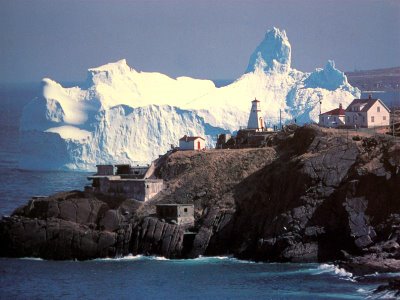A city of fire and ice
Day 14: St. John's
After endless days of good weather our luck was bound to run out, and today we got a taste of good old-fashioned Maritime weather. Eight degrees, heavy overcast, on and off drizzle and a stiff wind persisted all day until just before sunset. We knew there wasn't too much to see in St. John's so we took it easy in the morning, not leaving the B&B until just a little before noon.
St. John's is a surprisingly large city, with a very small feel. Street upon street of colourful clapboard row houses climb the hills that hug the harbour and give the historic downtown area that fishing village charm. They're bright and cheery but at the same time look as if they are permanently dug in against the wind and the cold. While the old downtown area is fairly compact, walking around means tackling the steep inclines - some so impressive that you wonder how it is that all the cars don't slide right down and into the water when the snow and ice hit in the winter.
And speaking of ice, every year during late spring and early summer, St. John's (and other parts of northeastern Newfoundland) are privy to the Parade of Icebergs, hundreds (sometimes more) of massive ice calved from the Arctic and Greenland continental ice shelves that float down from Arctic waters creating great spectacles like the one you see in the picture above. I would love to say that we actually saw a scene like that for ourselves, but in fact it is a photograph of a fairly well-known photograph in these parts, of a particuarly massive iceberg that passed by St. John's Harbour in 1996. Unfortunately, September is well out of iceberg season, so the only ice we've seen has been in our drinks.
St. John's seems to have troubles at the other end of the spectrum as well, falling victim to numerous city fires, the ones in 1846 and 1892 so big that they got the "Great Fire of" designation. The current layout of the old downtown area is apparently a post-1892 result of trying to make it a little more fire resistent. Seems to have worked.
This morning, not being able to glean much from the tourist info that we had, we were heading for the information office to get a personal opinion when we happened upon St. John the Baptist Anglican Cathedral. The door was open and a sign outside was inviting passers-by for a tour, so we went in to have a look. We couldn't have expected the grand interior that awaited us. Only a century old but built in the gothic revival style, the interior was a splendid combination of Scottish-quarried sandstone pillars and arches, while the walls were old stone quarried locally. An arched ceiling of beautiful dark-stained British Columbia pine covered the rows of solid oak pews below. With the relatively small size of the cathedral, the whole effect was simply stunning. It was old in style but felt newly built; it was gothic but had a feeling of warmth and coziness, the exact opposite of the empty and cold atmosphere of most gothic style churches. Happening on the cathedral was fortunate enough, but as luck would have it we also were there at the same time as another tourist who happened to be an organist in her home town. The nice ladies on duty this morning invited her to play the gorgeous Casavant organ with its 3500 pipes located in the front portion of the church. As the hymns resonated among the stones walls, we walked the aisles, taking in the architecture and the stained glass masterpieces.
We made a quick stop at the fairly empty tourist office and then went for a bite at a bakery/deli that was emitting the scents of fresh-baked bread that were just too good to resist. We went for the sandwich special of the day: turkey (real meat) and stuffing with a cranberry-mayo sauce on multi-grain, and it felt like Thanksgiving had come early.
Back on the street the drizzle had let up, but we hopped in the car anyway to avoid a cold and windy walk up to Signal Hill. We stopped first at the visitor centre, completely renovated just this past July, where we watched a rather interesting little movie about the history of the site, mostly focusing on its military functions. After that, we drove up to Cabot Tower where there was a small exhibit on Marconi's famous reception of the first trans-Atlantic wireless signal on December 12, 1901. With all the fanfare and accolades given to Marconi, and to a lesser extent his assistant, Kemp, you have to wonder about the guy who was tapping out the messages in Poldu, England so that he could receive them. Is the other guy celebrated over in England as much as Marconi is here?
A busload of tourists showed up crowding things heavily, so we headed off to Cape Spear, the most easterly point on the North American continent. The Canadian flag was flapping stiffly in the strong, cold wind, so we read a few plaques, snapped a few photos, and headed back to the city. It wasn't a particularly packed day, but not too exhausting either, and given the weather, not a bad day spent. So with today's shortened report, and given that we are just past the halfway point of the trip, I thought I'd share the trip so far, by the numbers, as of September 17th:
Days: 13
Kilometres driven: 5506
Average speed: 83.2 km/h
Provinces travelled: 6
Capitals visited: 5 provincial, 1 national
Number of gas stops: 14
Amount spent on gas: $466.36
Lowest gas price (regular): 82.9; Mallorytown, Ontario; Day 1
Highest gas price (regular): 105.3; Grand Falls-Windsor, Newfoundland; Day 13
Longest distance between gas stops: 682km
Shortest distance between gas stops: 2.5km
Average fuel economy: 8.6L/100km
Different Canadian province licence plates seen: 10
Different American state licence plates seen: 26
Most expensive meal: $40.00 (dinner, Harbour Restaurant, Cheticamp, NS)
Least expensive meal: $2.10 (lunch, Mike's Place, Pleasant Bay, NS)
Highest outdoor temperature (while in car): 24C (near Halifax, NS, 3:00pm, Day 10)
Lowest outdoor temperature (while in car): 3C (Port-aux-Basques, 7:30am, Day 13)
Speeding tickets: 0
Free car washes: 1
Kilometres driven: 5506
Average speed: 83.2 km/h
Provinces travelled: 6
Capitals visited: 5 provincial, 1 national
Number of gas stops: 14
Amount spent on gas: $466.36
Lowest gas price (regular): 82.9; Mallorytown, Ontario; Day 1
Highest gas price (regular): 105.3; Grand Falls-Windsor, Newfoundland; Day 13
Longest distance between gas stops: 682km
Shortest distance between gas stops: 2.5km
Average fuel economy: 8.6L/100km
Different Canadian province licence plates seen: 10
Different American state licence plates seen: 26
Most expensive meal: $40.00 (dinner, Harbour Restaurant, Cheticamp, NS)
Least expensive meal: $2.10 (lunch, Mike's Place, Pleasant Bay, NS)
Highest outdoor temperature (while in car): 24C (near Halifax, NS, 3:00pm, Day 10)
Lowest outdoor temperature (while in car): 3C (Port-aux-Basques, 7:30am, Day 13)
Speeding tickets: 0
Free car washes: 1



0 Comments:
Post a Comment
<< Home